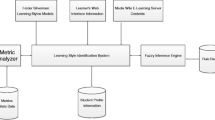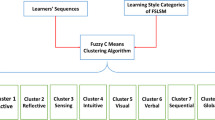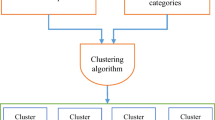Abstract
Learners style is grouped into four types mainly; Visual, auditory, kinesthetic and Read/Write. Each type of learners learns primarily through one of the main receiving senses, visual, listening, or by doing. Learner style has an effect on the learning process and learner’s achievement. It is better to select suitable learning tool for the learner according to his learning style. In this work, a fuzzy model for predicting learner style depending on characteristics of the learner is proposed. The system was tested on a group of students and compared to their results from the online VARK questionnaire which is a tool that is used to give the students information on how to maximize their learning. The new proposed fuzzy inference system gave 48 % similar classification compared with the VARK.
















Similar content being viewed by others
References
Alian, M. (2011) Formalization and Implementation of Eliminating and Optimizing Selection, (EOS) approach, Education and Information Technologies: Volume 16, Issue 1, pp. 89–103. doi: 10.1007/s10639-009-9113-0,“Special Issue: Online Learning Technologies”, Springer 2011.
Almohammadi, K., & Hagras, H. (2013). An adaptive fuzzy logic based system for improved knowledge delivery within intelligent ELearning platforms. IEEE International Conference on Fuzzy Systems, 1–8. doi:10.1109/FUZZ-IEEE.2013.6622350.
Barbe, W. B., Swassing, R. H., & Milone, M. N. (1979). Teaching through modality strengths: concepts and practices. Columbus: Zaner-Bloser.
Berry, D. C., & Broadbent, D. E. (1990). The role of instruction and verbalization in improving performance on complex search tasks. Behavior & Information Technology, 9, 175–190.
Berti, S., & Schroger, E. (2001). A comparison of auditory and visual distraction effects: behavioral and event-related indices, research report. Cognitive Brain Research, 10(2001), 265–273.
Clemons, S. A. (2004). Developing on-line courses for visual/kinesthetic learners: a case study. International Journal of Instructional Technology and Distance Learning, 1(11), 51–62.
Crockett, K., Latham, A., Mclean, D., & O’Shea, J. (2013). A fuzzy model for predicting learning styles using behavioral cues in a conversational intelligent tutoring system. IEEE International Conference on Fuzzy Systems (FUZZ), 2013, 1–8.
Dunn, R., Griggs, S. A., Olson, J., & Beasly, M. (1995). A meta-analytic validation of the Dunn and Dunn model of learning style preferences. Journal of Educational Research, 88, 353–362.
Fleming, N.D. (1995). I’m different; not dumb. Modes of presentation (VARK) in the tertiary classroom, in Zelmer,A., (ed.) Research and Development in Higher Education, Proceedings of the 1995 Annual Conference of the Higher Education and Research Development Society of Australasia (HERDSA),HERDSA, Volume 18, pp. 308–313.
Fleming, N. (2001). How do I learn best: A student’s guide to improved learning: VARK - visual, aural, read/write, kinaesthetic.
Fleming, N., Baume, D. (2006) Learning Styles Again: VARKing up the right tree! Educational Developments, SEDA Ltd., Issue 7.4, Nov. 2006, pp.4–7.
Fleming, N. D. Mills, C. (1992), Not Another Inventory, Rather a Catalyst for Reflection From To Improve the Academy, Vol. 11, 1992. Page 137.
Georgiou, D. A., Botsios, S., Mitropoulou, V., Papaioannou, M., Schizas, C., & Tsoulouhas, G. (2011). Learning style recognition based on adjustable three-layer fuzzy cognitive map. JAISCR, 2011, 1(4), 333–347.
Girija, N. C. (2015),Visual, Auditory and Kinesthetic Approach to Enhance the Information Processing Ability in Teaching Learning Teaching Chemistry, International Educational E-Journal, Volume-IV, and Issue-I, Jan.-Feb.-Mar 2015, pp.: 61–66.
Godin, G., & Shephard, R. J. (1985). A simple method to assess exercise behavior in the community. Canadian Journal of Applied Sport Science, 10, 141–146.
Huseyinov, I.N. (2011), Fuzzy Linguistic Modelling Cognitive / Learning Styles for Adaptation through Multi-level Granulation, Human Computer Interaction Users and Applications, Volume 6764 of the series Lecture Notes in Computer Science, 2011, pp.: 39–47.
Leite, W. L., Svinicki, M., & Shi, Y. (2010). Attempted validation of the scores of the VARK: learning styles inventory with multi-trait-multimethod confirmatory factor analysis models. Educational and Psychological Measurement., 70, 323–339.
Marcy, V. (2001). Adult learning styles: how the VARK learning. Perspective on Physician Assistant Education, 12(2), 117–120.
Mullen, S. P., Olson, E. A., Phillips, S. M., Szabo, A. N., Wójcicki, T. R., Mailey, E. L., Gothe, N. P., Fanning, J. T., Kramer, A. F., & McAuley, E. (2011). Measuring enjoyment of physical activity in older adults: invariance of the physical activity enjoyment scale (paces) across groups and time. The International Journal of Behavioral Nutrition and Physical Activity, 8, 103.
Raedeke, T. (2007). The relationship between enjoyment and affective responses to exercise. Journal of Applied Sport Psychology, 19, 105–115. doi:10.1080/10413200601113638.
Reid, J. M. (1987). The learning style preferences of ESL students. TESOL Quarterly, 21(1), 87–111.
Sbattella, L., Tedesco, R. (2004), Profiling and tutoring users in virtual campus, ITHET 2004. Proceedings of the Fifth International Conference on Information Technology Based Higher Education and Training, (2004). pp. 256–262.
Shute, V. J. and Zapata-Rivera, D. (2012), Adaptive educational systems, Adaptive technologies for training and education, pp. 7–27, 2012.
Zhang, K. Bonk, C.J. (2008). Addressing diverse learner preferences and intelligences with emerging technologies: Matching models to online opportunities. Canadian Journal of Learning and Technology, V34 (2) Spring, 2008.
Author information
Authors and Affiliations
Corresponding author
Rights and permissions
About this article
Cite this article
Alian, M., Shaout, A. Predicting learners styles based on fuzzy model. Educ Inf Technol 22, 2217–2234 (2017). https://doi.org/10.1007/s10639-016-9543-4
Published:
Issue Date:
DOI: https://doi.org/10.1007/s10639-016-9543-4




